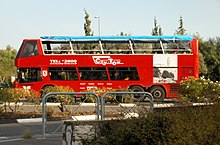
Tel Aviv-Yafo, sometimes rendered as Tel Aviv-Jaffa, and usually referred to as just Tel Aviv, is the most populous city in the Gush Dan metropolitan area of Israel. Located on the Israeli Mediterranean coastline and with a population of 474,530, it is the economic and technological center of the country and a global high tech hub. If East Jerusalem is considered part of Israel, Tel Aviv is the country's second-most-populous city, after Jerusalem; if not, Tel Aviv is the most populous city, ahead of West Jerusalem.

Transportation in Israel is based mainly on private motor vehicles and bus service and an expanding railway network. A lack of inland waterways and the small size of the country make air and water transport of only minor importance in domestic transportation, but they are vitally important for Israel's international transport links. Demands of population growth, political factors, the Israel Defense Forces, tourism and increased traffic set the pace for all sectors, being a major driver in the mobility transition towards railways and public transit while moving away from motorized road transport. All facets of transportation in Israel are under the supervision of the Ministry of Transport and Road Safety.

Ben Gurion International Airport, commonly known by the Hebrew-language acronym Natbag, is the main international airport of Israel. Situated on outskirts north of the city of Lod and directly south of the city of Or Yehuda, it is the busiest airport in the country. It is located 45 kilometres (28 mi) to the northwest of Jerusalem and 20 kilometres (12 mi) to the southeast of Tel Aviv. It was known as Lod Airport until 1973, when it was renamed in honour of David Ben-Gurion (1886–1973), the first prime minister of Israel. The airport serves as a hub for El Al, Israir Airlines, Arkia, and Sundor, and is managed by the Israel Airports Authority.

The Tel Aviv Light Rail, also known as Dankal is a mass transit system for Gush Dan, the Tel Aviv metropolitan area in central Israel. The system will include different modes of mass transit, including rapid transit (metro), light rail transit (LRT), and bus rapid transit (BRT). Overseen by NTA Metropolitan Mass Transit System Ltd., a government agency, the project will complement the intercity and suburban rail network operated by Israel Railways.
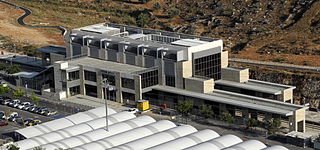
Jerusalem–Malha railway station was one of two Israel Railways termini in Jerusalem, the other being Jerusalem–Yitzhak Navon railway station. The station is located in the southern neighborhood of Malha, across from the Jerusalem Shopping Mall, Pais Arena and Teddy Stadium.

Superbus is an Israeli bus company, which provides intercity and urban service in Afula, Tiberias, Yokneam and Jerusalem.

Nahariya railway station is a railway station serving the city of Nahariya, Israel, and the surrounding towns and villages of the Western Galilee region. It is the northernmost passenger station in Israel and is currently the terminus of the north–south coastal line.
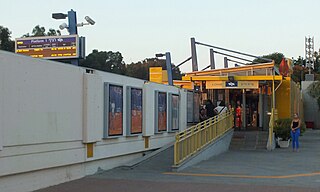
Kiryat Haim railway station is an Israel Railways passenger station serving Haifa's borough of Kiryat Haim and its immediate surrounding region.

Binyamina railway station is an Israel Railways passenger station located in the region of Binyamina-Giv'at Ada and serves these towns, as well as Zikhron Ya'akov, Or Akiva and other small communities in the area.
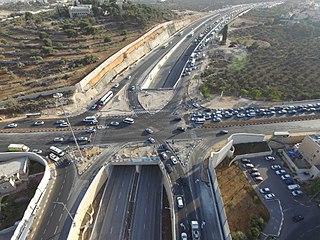
Highway 50, officially called Begin Boulevard and also referred to as Menachem Begin Expressway or Begin Highway, is a north-south urban freeway, through western Jerusalem, named after Israel's sixth Prime Minister, Menachem Begin. Local Jerusalemites simply refer to it as 'Begin'. It enters Area C of the West Bank on the north end and East Jerusalem on both ends.

Jaffa Road, also called Jaffa Street is one of the longest and oldest major streets in Jerusalem. It crosses the city from east to west, from the Old City walls to downtown Jerusalem, the western portal of Jerusalem and the Jerusalem-Tel Aviv highway. It is lined with shops, businesses, and restaurants. It joins with Ben Yehuda Street and King George Street to form the Downtown Triangle central business district. Major landmarks along Jaffa Road are Tzahal Square, Safra Square, Zion Square, Davidka Square, the triple intersection (Hameshulash) at King George V Street and Straus Street, the Ben Yehuda Street pedestrian mall, the Mahane Yehuda market, and the Jerusalem Central Bus Station. Jaffa Road has been redeveloped as a car-free pedestrian mall served by the Jerusalem Light Rail, as well as by the Jerusalem–Yitzhak Navon railway station directly adjacent to the Central Bus Station.

Rishon LeZion–HaRishonim railway station is a station of Israel Railways in Rishon LeZion, part of the Tel Aviv – Rishon LeZion line. The station is located in the southern area of the city, in the middle of HaRishonim Interchange, at the intersection of the new Highway 431 and Route 412. It was opened on September 13, 2003, with the Beit Shemesh railway station. The station has two platforms. It is the southern terminus of the suburban line to Netanya.
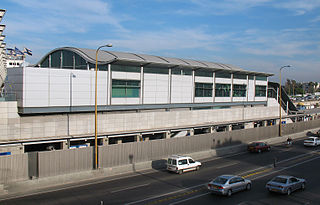
Tel Aviv–HaHagana railway station is a major railway station on the Ayalon Railway in southern Tel Aviv, Israel, serving most lines of Israel Railways. It is located in the median of the Ayalon Highway, north of Highway 1 and 400 meters east of the Tel Aviv Central Bus Station. In 2019, over six million passengers used the station, making it the third-busiest in the country after the nearby Savidor Central and HaShalom stations at the time; it was subsequently overtaken by Jerusalem–Yitzhak Navon and demoted to fourth place, but remains the third-busiest station in Tel Aviv.
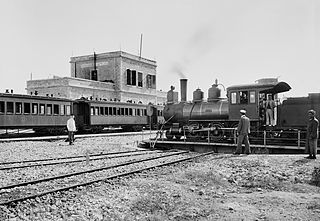
The Jaffa–Jerusalem railway is a railway that connected Jaffa and Jerusalem. The line was built in the Mutasarrifate of Jerusalem by the French company Société du Chemin de Fer Ottoman de Jaffa à Jérusalem et Prolongements and inaugurated in 1892. The project was headed by Joseph Navon, an Ottoman Jewish entrepreneur from Jerusalem, after previous attempts by the British-Jewish philanthropist Sir Moses Montefiore failed. While the first rail track in the Middle East was laid elsewhere, the line is considered to be the first Middle Eastern railway.

Bnei Atarot is a moshav in the Central District of Israel. Located near Yehud, around 15 kilometres east of Tel Aviv, it is situated in fertile plains at the eastern rim of Tel Aviv metropolitan area next to Ben Gurion Airport and falls under the jurisdiction of Hevel Modi'in Regional Council. In 2022 it had a population of 934.

The Tel Aviv transportation system is seen as the hub of the Israeli transport network in terms of road, rail, and air transport. The Israeli road network partly centers on Tel Aviv, with some of the country's largest highways passing through or running to the city. The city forms a major part of the country's rail network, whilst Ben Gurion International Airport located near the city is the country's largest airport. There is also a strong public transport system within the city, based primarily on bus transportation.

The Tel Aviv–Jerusalem railway is a railway line in Israel connecting the cities of Tel Aviv and Jerusalem. The line serves as the main rail link between the two cities, complementing the old Jaffa–Jerusalem railway. As such, the railway is often referred to in Israel as the high-speed railway to Jerusalem to distinguish it from the older, longer and slower line. In spite of that name, the line is not high-speed under the definition used by the International Union of Railways: both its design speed of 200 km/h (125 mph) and its current operational speed of 160 km/h (99 mph) are below the 250 km/h (155 mph) threshold used by the UIC to define high-speed railways, and it is traversed by IR's regular rolling stock instead of the UIC requirement for specially-designed high-speed trains.
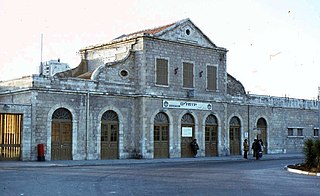
The Jerusalem railway station is a historic railway station in Jerusalem, located between Hebron Road and Bethlehem Road, near the German Colony. It is also known as the Jerusalem–Khan railway station after the caravanserai building, now the Khan Theater located across the road, to differentiate it from the Jerusalem–Malha and Jerusalem–Yitzhak Navon stations opened after its closure. It was part of the Jaffa–Jerusalem railway until its closure in 1998.
The Israeli city of Beersheba occupies a central role in southern Israel. Because of its central position in the Negev it is situated on important national routes reaching down to the far southern port of Eilat. Be'er Sheva is also home to a population of 195,000, with an estimated metro population at over 500,000 making it one of the largest cities in Israel. Much of the cities high-tech industry is concentrated in the center of the city, with Industrial estates existing in the south of the city, both of these areas are thus extensively served.

The Purple Line is a light rail transit (LRT) line under construction in the Tel Aviv metropolitan area in Israel. The line will operate as part of the planned Tel Aviv metropolitan area mass transit system and is expected to be the second line to open. The line will connect the city centre of Tel Aviv with its eastern suburbs of Yehud and Giv'at Shmuel.


